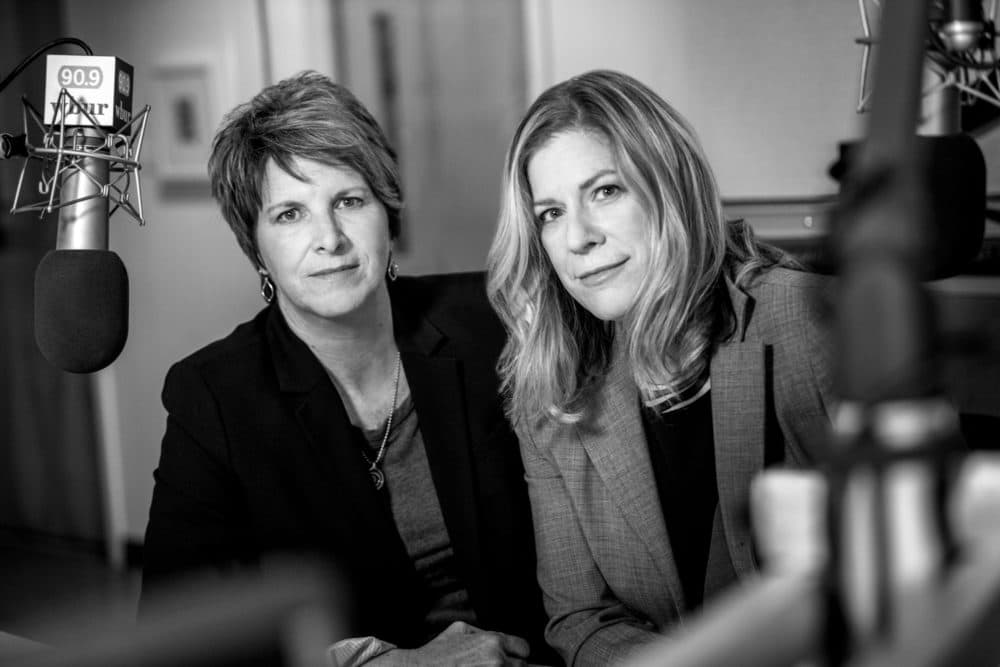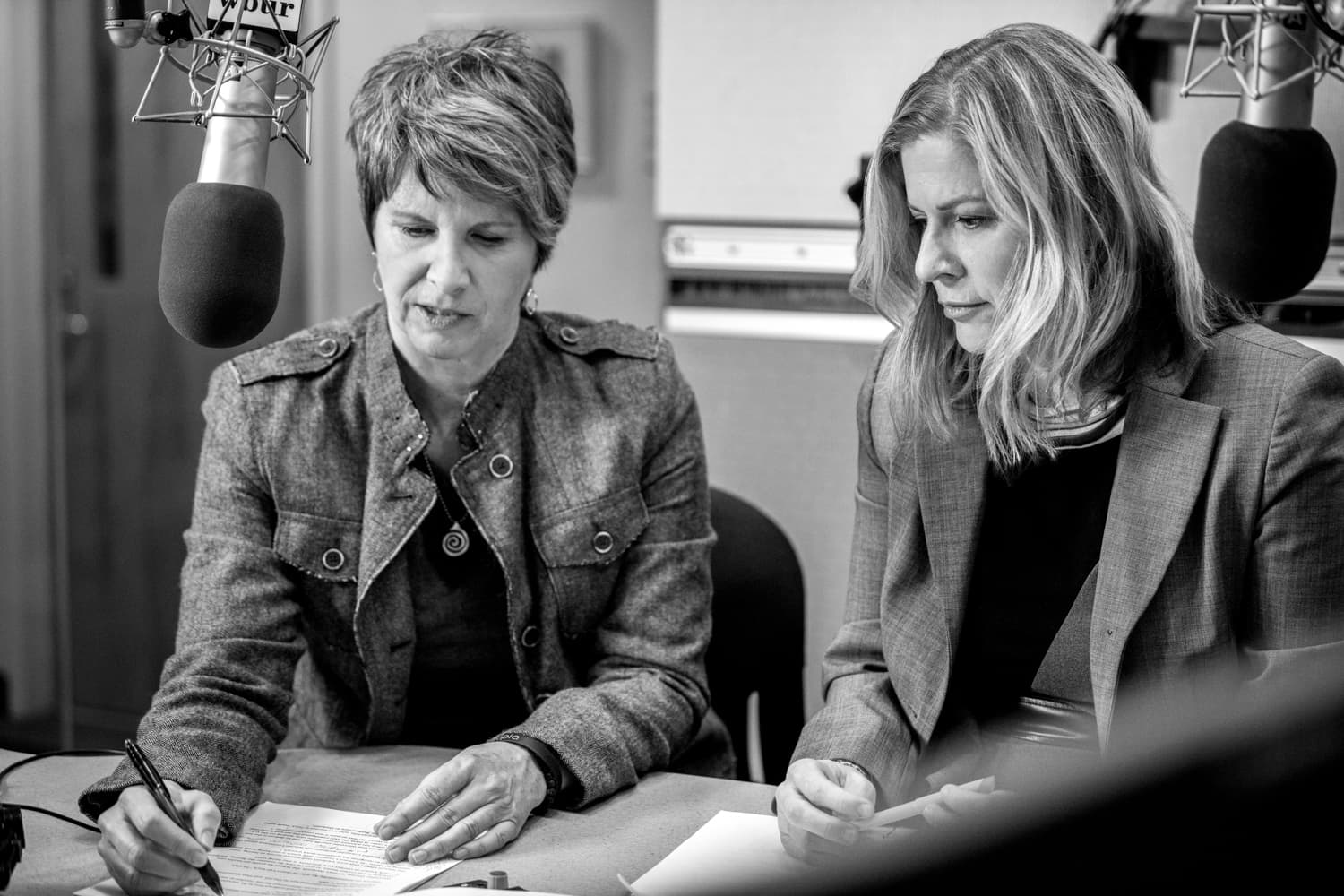Advertisement
Answers To Your Questions About Investigative Journalism At WBUR

In 2018, WBUR launched a new investigative unit to expand its reporting, with a mission to produce deeply reported stories about subjects that affect the lives of people living in New England. Funded by The Campaign for WBUR, the team is led by Christine Willmsen, Pulitzer-prize-winning journalist, joined by Beth Healy, a former member of the award-winning Spotlight team at the Boston Globe.
As they prepare to release their first in-depth investigative series, the team took some time to talk to INSIDE WBUR about the inner-workings of investigative journalism in a local newsroom:
What is the vision of ‘WBUR Investigations’? How does this team interface with the newsroom?
Christine Willmsen: While the newsroom focuses on answering the facts of who, what and where and when something happened, Beth and I get together to investigate how and why it happened. Our aim is to work on the longer game that answers those deeper questions people have in the aftermath of a story or to pull back the curtain on something that hasn’t been a story—yet.
Beth Healy: We want to hold powerful people and institutions to account. We want to look deeply at different parts of the world, whether it's government or businesses or nonprofits. Our investigations will be locally rooted but often the stories will have legs, making them regional or even national.
Investigative journalism, especially now, isn't just about digging into a story and disappearing for a year. We enjoy doing the deep dives but we also want to focus on quick turnaround stories. If there's a big story, we want to be available to jump on it with our fellow journalists in the newsroom.

Willmsen: There's always a certain threshold or a minimum story we start with. I want to know if there’s more to a story—can I dig in further? Is it a novel story? Has it been reported on before? Does it have investigative underpinnings, where we can go after records and find sources? Are there multiple dimensions to building the blocks of the investigation and is there potential impact as a result of the investigation? Then comes the balancing act of the resources, time and energy required to produce the story.
Healy: A lot of times, in investigative work, we'll ask, is there wrongdoing? Can we get the story? Are people going to care? Is this going to create an impact?
So does impact play a huge role in your decision-making on which stories to pursue?
Willmsen: Certainly, you want impact. We hope there's somebody who looks at this and says, “Well, something's got to change.” But if that's always the threshold, there are so many stories we won't end up doing. We have no control over what impact a story will have.
I often look at the stories that have more nuance—stories where we're uncovering something you might not know, but you might potentially care about. I think those are some of the most important stories to tell. The minimum on investigative reporting is that you're sharing something that people are unaware of.
Christine Willmsen
Healy: Investigative reporting is inherently risky. You put all your resources into something that you believe matters or you hope is going to matter to readers and listeners. But then, what the world does with the story afterward is up to them.
What is a day like in the life of an investigative reporter?
Healy: Investigative reporting is just like all other good reporting. The great Walter Robinson said, “There aren’t investigative reporters, there are just reporters. And everyone should really just be an investigative reporter.” You spend most of your time talking to people. You go through tons and tons of documents. Often we are doing some very nitty-gritty, dare I say, tedious work. Often, you are poring through records and creating chronologies and spreadsheets.
Willmsen: What’s different from daily reporting is relentlessly trying to get a hold of someone. We're calling people 8-10 times over the course of weeks, trying to get them to talk to us. We’re in constant pursuit to get all sides of a story. Our work is also a lot about building relationships with the people we talk to. You create a certain level of trust and rapport with them that you’ve got to do justice to. You carry a lot of people's emotions in your hands. These people are sharing something with us that possibly they've never shared with anyone else. That's the heavier part of investigative reporting.
Most good investigations you could not do without some very brave people being willing to talk to us and go on the record. I think we spend a lot of time, including during this series we’re working on, telling people, “Look, I know this is hard, but your story is so important.”
Beth Healy
Healy: We try to bring people in. And if it weren't for them, we really couldn't tell these stories.
Willmsen: We also do a lot of digging. We ask for public records. You'll find investigative journalists in police departments, in courthouses, in the city’s permit office, you name it. You're digging in any and every place imaginable. Oftentimes for records that people don't even know exist.
Healy: And I want to give a shout-out here for fairness. We, as journalists at all the great places we’ve worked at before and certainly at WBUR, have a very high bar for fairness. We have a big responsibility. Our intention is to give people the opportunity to share their perspective, the opportunity to help shape the reporting.
How do you keep bias out of your reporting?
Healy: Everybody has inherent bias. But what reporters do is bend over backward to get all sides of the story. The beauty of good reporting is that it doesn't really matter what you think! It matters that you ask everybody that you're reporting on their opinion and that your story reflects that reporting—and you leave your bias over there.
Willmsen: We want the voices of who we’re reporting on reflected in the story, not ours. I also talk a lot to other people to make sure I don't have blinders on. And that's where a team is super helpful. Beth & I talk constantly, always having conversations so that we're giving everybody their due.
When do you know that your investigative story is done and ready to be published?
Willmsen: I still won't feel like it's done even a month after publishing sometimes because… it’s a living, breathing thing. You hope that there are follow-ups. We already have ideas of stories we want to do after the series we’re working on. It doesn't really end when you hit publish or go on-air.
Healy: Stories do have a shape. A great investigative editor once told me that a story is about just one thing. Once you find yourself—as reporters inevitably do—going down rabbit holes, you start to realize those should be follow-ups. There's only so much that people can take in when you’re trying to make a powerful point.
How powerful is audio for investigative reporting?
Healy: I worked on audio before at the Globe, when we published Gladiator (a look at the crisis facing football through the lens of Aaron Hernandez's life and crimes). Audio has the ability to put another layer into investigative reporting. Because you've got to get the sound, you have to get people to go on tape. When it works, it's very powerful.
When you interview somebody and end up using one of their quotes or clips in a radio investigation, you never forget their voice and what they say.
Christine Willmsen
Willmsen: ... And that's a different element that I am finding so interesting—once you hear them in their own voice, it’s so much richer and so much more intense. It lives in your brain. They're sharing their story. We're not telling it. Sometimes it's actually really difficult to hear these people. It is uncomfortable.
What is the process like before an investigative story sees the light of day?
Willmsen: There are a lot of steps before a story goes on-air or goes online, including a legal team vetting your story. 75-85% of the time in the process, we'll be reporting. Then the next 15% is really the writing, structure, organizing and the copyediting—
Healy: Who hasn't done an investigation where the copy editor has saved your life?
Willmsen: Absolutely. Also Beth & I, besides sharing it back and forth between us, ask for other people's feedback. All these processes are so incredible and important. Every single step matters.
For us, as investigative reporters, it's so important that the public understand what we do. In the old days, we didn't want to tell anybody—we just wanted to drop an investigation and hoped readers would pay attention. But it’s becoming more and more important for people to understand how we get the stories, as well as the degree of difficulty that's involved.
WBUR Investigations pursues stories that hold powerful institutions and people to account. The debut series from the team is coming this spring.
